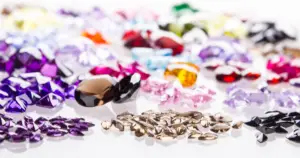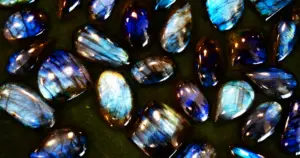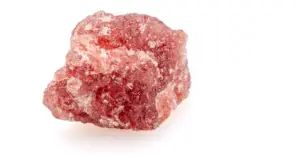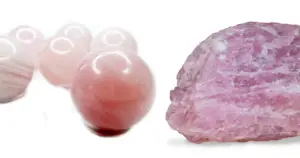How to Tell if Amethyst is Real or Fake in 3 Easy Ways
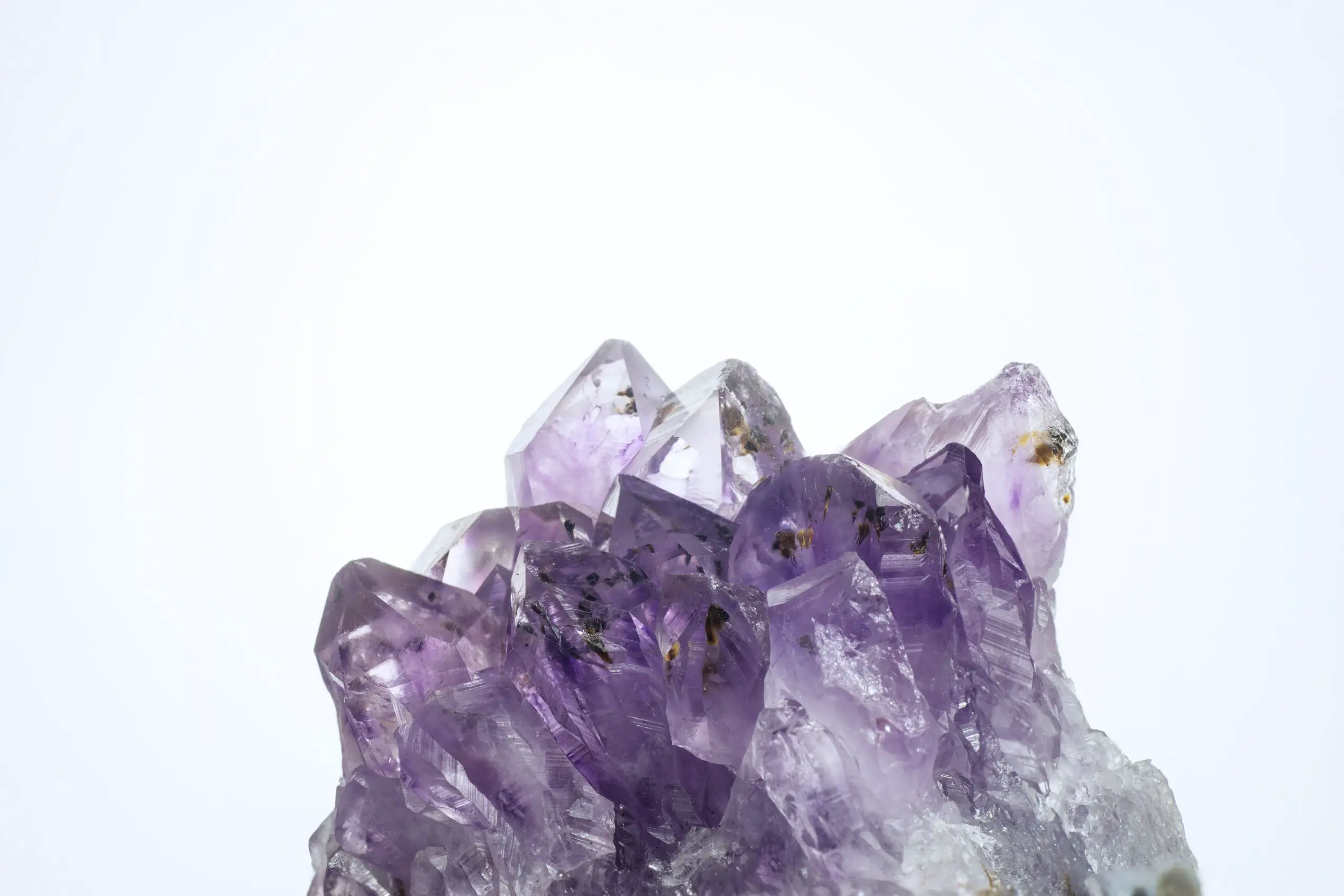
Amethyst is a semi-precious gem prized because of its color and hexagonal crystal structure. Due to its abundant occurrence, there is little incentive to synthesize amethysts and read to know how you can tell if Amethyst is Real or Fake.
More often, amethysts are masked and marketed as other more expensive stones. It forms in shatter faults, or vugs, where large amounts of quartz settle, crystallize and terminate into lavender hexagons depending upon the enrichments of manganese and hematite.

Table of Contents
How to Identify if Amethyst is Real or Fake?
Observe the Kind and Spread of Coloration across the Crystal
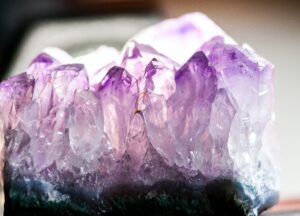
Amethyst has a long history of being used as a healing stone. The word ‘Amethyst’ in fact derives from the Ancient Greek ‘amethystos’, meaning “not drunk.”
Some linguists argue that it was named after its color, which resembles the color of watered-down wine. It was believed that you could remain sober after a full night’s drinking if you carried an amethyst in your mouth or drank out of amethyst tumblers.
Mythologically, amethyst is said to have acquired its purple color from a cup of wine poured onto it by Bacchus, the Roman god of agriculture. There are several references to the amethyst stone in the Bible, including its mention as one of the twelve stones set in the breastplate of Aaron, the High Priest of Israel. The ancient Egyptians associated this stone with their zodiac symbol of the goat.
But you don’t have to know any of this to know that amethyst is a beautiful gem, the birthstone of February, steeped in Biblical heritage, and truly a prized addition to any collection.
Amethyst falls in the class of quartz family minerals. It gets its characteristic purple color from the presence of iron impurities at the time of quartz formation. The color in any given amethyst crystal will vary depending upon the concentration of iron in it.
- The color on a naturally occurring amethyst typically ranges from a deep reddish-purple to a pale lilac or grayish purple across the length of the crystal.
- Usually, the deeper violet on the crystal is concentrated on the tips, progressively fading out as it travels to the base.
- This is what gemologists call ‘zoning’: distribution of color across zones contingent on mineral concentrations. All-natural amethysts necessarily show irregular chromatism.
- For singular uncut crystals/ geodes observe the pattern, intensity, and arrangement of color.
Amethyst crystals may occur in several patterns of color distribution, of which the readily identifiable ones are those that concentrate the color on
- Their Tips
- On parallel faces across the length of the crystal
- On the alternative rhombohedral faces, making the crystal appear like a windmill with petals of alternating color on top
Check if the Color of a natural Amethyst Crystal Fades over time?
Yes, natural amethysts, when exposed to direct sunlight, over extended periods, may start to lose their deeper hues and become paler.
This is because of over-exposure to ultraviolet radiations from being under direct sun. The exposure threshold varies among amethysts, which means that there is no way to foretell how fast or slow the color of a crystal will fade.
You can prevent this by avoiding long amounts of direct sunlight on your crystal and by keeping it secure in dark-colored pouches.
Scrutinize the Cut of the Crystal
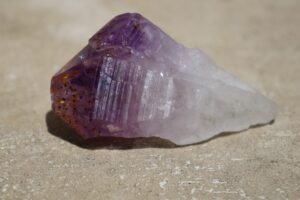
Amethyst grows on large matrix rocks, which are often centuries-old volcanic rocks, and sometimes as scepters (Second generation crystal formation) on top of older rock crystals or smoky quartz.
The individual crystals are rhombohedral in shape and often look like pointy teeth. If you are buying a polished stone, a lack of crystal points can indicate that it is synthetically made.
This is because most synthetically produced amethyst is produced in large blocks, which is very different from the natural process of cumulative mineralization on a bedrock.
Industrially made amethysts are sometimes cobbled into smaller pieces and given angular carvings to make them appear real. However, these pieces will likely have no points. Observe the differences between a lab-made and natural amethyst gemstone below:
Fake vs Real Amethyst Gemstones
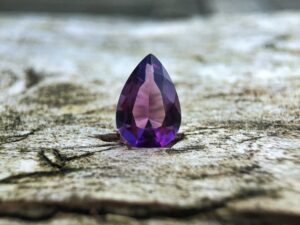
The color of the synthetic amethyst is a deeper evenly-spread violet which is often the result of the alkaline solution it is synthesized in.
Observe the difference in the prismatic formation and luster of the natural amethyst on the bottom and the smoothened surface of the synthetic stone on top.
Check if they are Large-sized Geodes
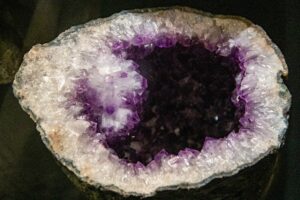
Size is often a good giveaway of a crystal being an imitation. If you are being sold an amethyst stone that is very large and has great deep color, especially for the price, beware. Most geodes of amethysts are heat treated to enhance color.
Try buying singular uncut crystals instead. If the gemstones being sold to you look identical in both color and size, like the ones stacked in the image below, they are likely to be synthetic. Natural amethysts vary greatly in color and size.
Synthetic amethysts can appear more appealing due to their deeper violet hue and a matte finish. These are often cut from large slabs and therefore bigger.
Does the presence of Yellow or Orange hues in an Amethyst Crystal mean it is fake?
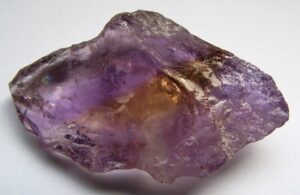
If a crystal containing violet and yellow hues is being marketed as an amethyst, it is not entirely wrong in its claims. While the stone is a rarer variety of amethyst, it is extremely prone to synthetic production. This is the fascinating world of the ametrine crystal.
Under very rare heat and pressure conditions in the earth’s mantle at the time of quartz formation, the iron impurities that lend amethyst its violet hue may occur alongside other impurities which give citrine its characteristic yellow hue.
When these impurities fuse in the quartz, the crystal formation so obtained is called an Ametrine.
Ametrine, as the name suggests, is a natural combination of citrine and amethyst. It is a member of the hexagonal crystal system but may be found as celestial crystals or in its massive form.
How to Identify a Fake Ametrine?
- Sellers may sometimes brand an ametrine as dichromatic (double-colored) amethyst or simply a rare amethyst to appear less intimidating to the consumers. But such branding is also often an occasion to mystify and sell industrially produced crystals.
- This is more so the case with a crystal-like ametrine, which not only seems to occur rarely but is also mined exclusively from Bolivia and Uruguay.
- Therefore, most ametrine/ dichromatic amethyst in the market is mass-produced. If you are being sold such a crystal, or already own, there are a few identificatory features you can keep in mind to weed off a fake ametrine:
- Natural Ametrine is a product of several irregularities in temperature, air pressure, and minerals in the environment. This causes it to have an uneven color gradient across the crystal with indiscrete banding and intermeshing patterns of yellowish-orange and purple zones.
- Typically with natural ametrines, the line of delineation between the two colors is not going to be razor-sharp
- The production of lab-made ametrines starts with citrine instead of amethyst and uses a linear accelerator to irradiate half of the stone turning it to purple, which gives these lab-made amterines a sharp divide between the two colors because the radiation is very directional
Is it Fake if an Amethyst Crystal contains Milky White Bands?
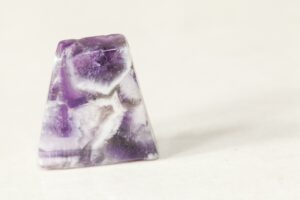
It is a purple and white, banded variety of massive quartz.These are not Fake Amethysts, but they are called Chevron Amethyst.
The purple bands are characteristic of and share the microscopic crystal structure of amethyst while the white bands resemble the properties of milky quartz.
The highest quality pieces of this variety of Amethyst occur in South Africa, but significant deposits are also found in India. Chevron amethyst is also sometimes referred to as banded amethyst or as Cape amethyst. They are typically opaquer than other amethysts.
Final Comments
Amethysts are a great place to start as a crystal collector because they’re plentiful; there’s a wide variety they can be had at relatively inexpensive amounts.
Despite its natural abundance, the economic viability of mass-producing amethysts has made it one of the most common and widely imitated crystals of all times.
In this article, we have covered a few of the several types of amethysts found in nature and how to identify their imitations. We also have identified three distinctive traits of amethysts crystal which can be used to differentiate them from their respective fakes: color, cut, and size.
These buying practices would help you while buying amethysts. Share this post to whom you care.
